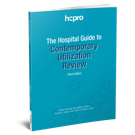Featured Case Management Solutions
Case Management
Newly Released Books
Books
- Case Management Patient Communication Toolkit
- Discharge Planning Guide: Tools for Compliance, Fourth Edition
- Medicare Compliance Essentials Training Compendium
- Patient Status Pocket Cards for Physicians (Packs of 20)
- Patient Status Training Toolkit for Medicare Utilization Review, Second Edition
- Pediatric CDI: Building Blocks for Success
- Social Work: Strength-Based Practice in Hospital Case Management
- The Hospital Guide to Contemporary Case Management
- The Hospital Guide to Contemporary Utilization Review, Third Edition
- The Physician Documentation Integrity Pocket Card (Packs of 25)
- The Provider Query Toolkit: A Guide to Compliant Practices
Boot Camps
- Boot Camp Training On-Site at Your Organization
- Case Management Boot Camp
- Live Virtual Medicare Boot Camp®—Utilization Review for Critical Access Hospitals
- Live Virtual Medicare Boot Camp®—Utilization Review for Medicare Advantage Version
- Live Virtual Medicare Boot Camp®—Utilization Review Version
- Medicare Boot Camp®—Utilization Review Version
- Medicare Boot Camp®—Utilization Review Version Online
Virtual Events
- Live Virtual Medicare Boot Camp®—Utilization Review for Critical Access Hospitals
- Live Virtual Medicare Boot Camp®—Utilization Review Version
Conferences and Forums
Continuing Education
Handbooks
- Case Management Patient Communication Toolkit
- Medicare Compliance Essentials Training Compendium
- Patient Status Training Toolkit for Medicare Utilization Review, Second Edition
- The Provider Query Toolkit: A Guide to Compliant Practices





 If for any reason you are not completely satisfied with an HCPro product, simply return it within 30 days of purchase and we will issue you a full refund.*
If for any reason you are not completely satisfied with an HCPro product, simply return it within 30 days of purchase and we will issue you a full refund.*